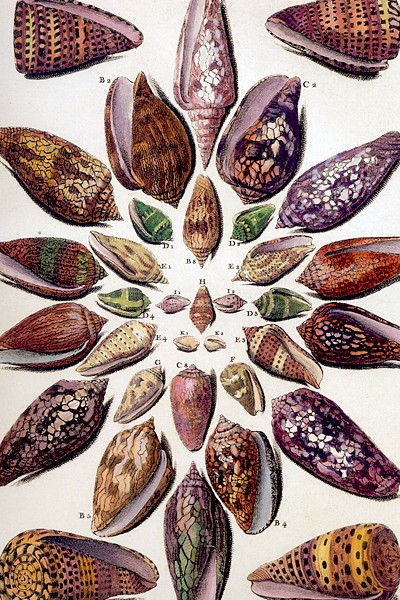
Gastropods such as Conus are not bilaterally symmetrical, that is, as the snail grows, its shell coils about a vertical axis. This spiraling growth can be in one of two directions, either right-handed (dextral) where the aperture of the shell is on the right or, much more rarely, sinistral if on the left. To represent the object with its proper orientation, a dextral shell must be drawn as a sinistral one—a mirror image of itself. Drawing it as it actually appears would otherwise produce a reversed image when printed. This usually makes no difference, even if the image were reversed. But it does when the shell is not symmetrical, as it is with the coiled shells of snails.
The earliest illustration of a shell is a wood-block print that appeared in 1475. Typically, shells drawn before about 1700 are presented as observed (recto). But, because they were not reversed on the wooden block or copper plate, the result is an inverted image on the printed page (verso). Dextral shells, which should have their aperture on the right, invariably are reversed and presented as sinistral, with the opening on the left, as are the shells to which Seba so proudly points in the print above. Still, there is no consistency; even though almost two-thirds of the gastropods illustrated in his Thesaurus are sinistral, the others are dextral.
Such representation seems not to have been an error on the part of the engraver but a deliberate choice. Presumably, it must have been easier to draw the subject as it appeared, even if that image were reversed on the printed page. Or, as Gould surmises, it may be that the correct orientation of objects that are not bilaterally symmetrical, such as cone shells, simply was not an important morphological detail. Allmon concludes that authors and artists (as well as engravers and printers) were unconcerned about the appearance of the shells they represented. If this truly was a convention of the time, then notions of accuracy in pre-eighteenth century zoology obviously must have been different from those of the present.
In 1674, Johann Daniel Major wrote a treatise on presenting a collection and put forth two principles in the representation of objects: they should be arranged with splendor and in their natural order. In a display of shells, for example, their nature was to be enhanced by systematic arrangement, which affirmed thereby the harmony of the universe and the unity of nature's complexity. He believed that the impulse to collect was itself innate in humans, who have a natural desire to enquire into God's creation. Indeed, the second article of the Dutch Confession of Faith (1561) directed the faithful to learn about God through the study of nature: "The whole world is before our eyes as a beautiful book, in which all created things, large or small, are as letters showing the invisible things of God." Van de Roemer tells of a poem by one Dutch collector, who, testifying to the might of the Creator, has the Precious Wentletrap summon the atheist to stand before the cabinet and ask himself who else but God could be responsible for such a beautiful work of art.

In this detail from d'Argenville's Conchyliologie (1780, Vol. I, Pl. XVIII), which has been hand colored (some rather imaginatively), one sees the elements of symmetry, variety, contrast, uniformity, and diversity that defined the nature of beauty and taste in the eighteenth century.
The frontispiece (top) shows Albertus Seba pointing to some of the shells in his collection: a Conus ammiralis, Venus (Pitar) dione, and Epitonium scalare ("Precious Wentletrap"), the greatest rarity of the time. It introduces his Locupletissimi rerum naturalium thesauri accurata descriptio. The third volume, dealing with shells, was published in 1758, the same year that Linnaeus published the tenth edition of his Systema Naturae. Linnaeus had visited Seba in 1735, when the second volume of the Thesaurus was published, and used many of Seba’s animals as type specimens for his own descriptions. One wonders, in fact, if the Venus dione in Seba's collection was the type specimen for Linnaeus' description of the shell. There are forty-six plates of shells in Seba's volume, approximately one-third of which are depicted as dextral, the others sinistral. Seemingly, there is no pattern to this representation; sinistral shells are followed by dextral ones and, in one instance, both orientations occur on the same page.
References: "Left Snails & Right Minds" (1995) by Stephen Jay Gould, Natural History, 104(4), 10-18; "The Evolution of Accuracy in Natural History Illustration: Reversal of Printed Illustrations of Snails and Crabs in pre-Linnaean Works Suggests Indifference to Morphological Detail" (2007) by W. D. Allmon, Archives of Natural History, 34, 174-191; "Scientific Symmetries" (2004) by E. C. Spary, History of Science, 42(135), 1-46. The illustrations are from Albertus Seba: Cabinet of Natural Curiosities (2001) by Irmgard Müsch, Jes Rust, and Rainer Willmann, and Antoine-Joseph Dezallier d'Argenville: Shells (2009) by Veronica Carpita, Rainer Willmann, and Sophia Willmann.
See also Conus cedonulli and da Costa.